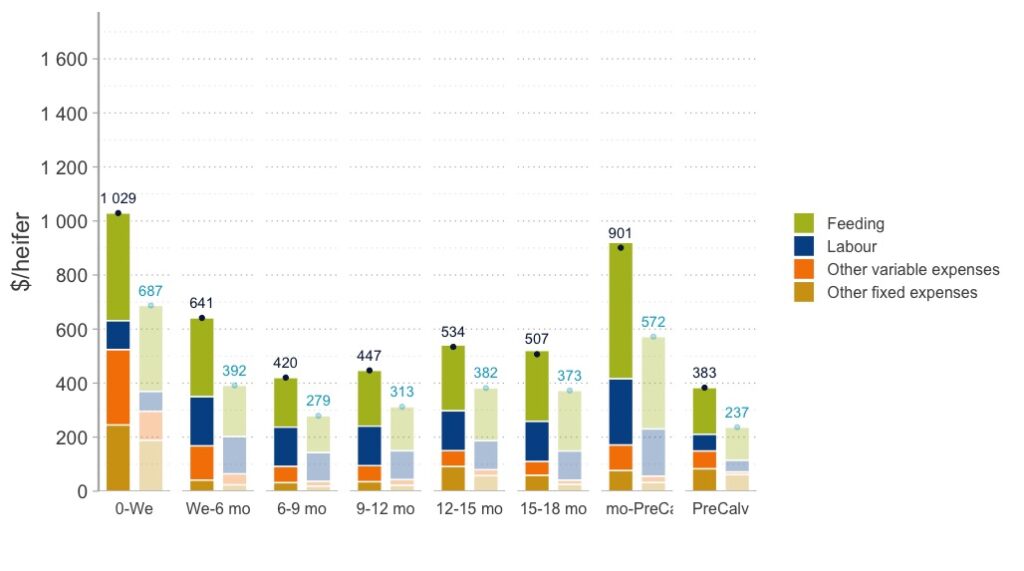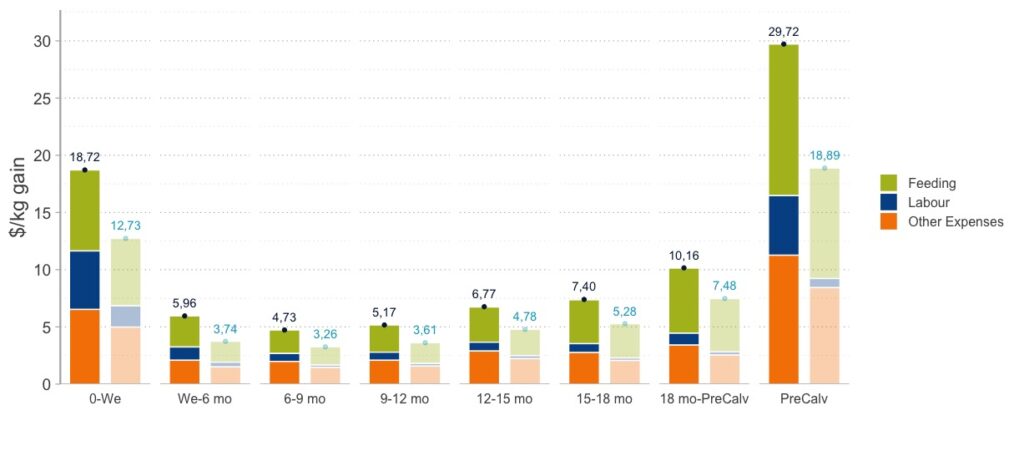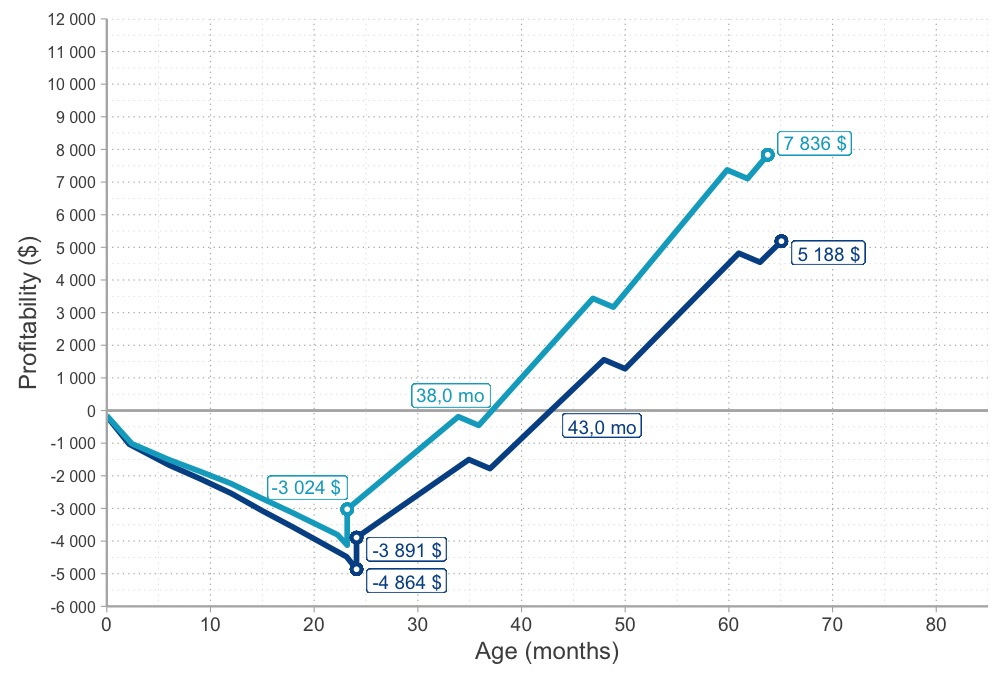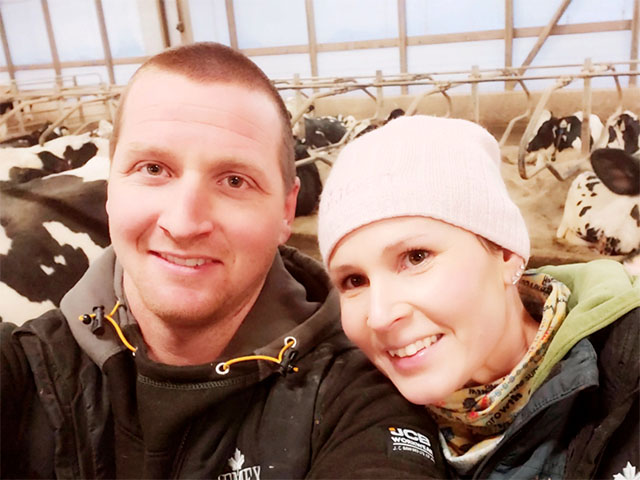Cost and profitability of rearing programs in Quebec
- November 27, 2023
The impact of heifer rearing on the production and economic performance of dairy farms is undeniable. Despite this, rearing programs are rarely fully evaluated, preventing farms from accurately identifying possible improvements to reduce costs, improve productivity and, ultimately, maximize profitability.
In light of this, Lactanet decided to conduct a research project in collaboration with Université Laval. The goal of the project was to include economic data along with growth and lactation performance measurements to analyze the costs and value of rearing programs in Quebec in 2021. For the study, 93 Quebec farms (87 conventional and 6 organic) were surveyed and visited. All herds predominantly raised Holsteins. In the September 2022 issue of this magazine, the preliminary results of this project pertaining to heifer maturity analysis were presented. In this article, we summarize the main results on rearing costs and lifetime profit for conventional herds.
Rearing Costs: A Significant and Variable Amount
To estimate rearing costs, the management consultants of the participating farms provided financial data, which served as the base. This data was supplemented with information collected at the farm on feeding, labour and other management factors for the various animal groups, from birth to first calving. Using this methodology, the average rearing cost per heifer in 2021 was estimated at $4,863, an amount significantly higher than the $4,300 estimate obtained using the Agritel database for the same year.
In addition to a higher rearing cost, the study found a wide variability for this cost among participating farms ($3,521 to $7,207). The variation did not seem to be linked to the length of the rearing period, which averaged 24.1 months.
How is this investment distributed over the rearing period?
To better understand how rearing costs are distributed over rearing phases, and where potential savings can be made, rearing costs were grouped by age range and broken down by category. Chart 1 illustrates this distribution for the median and the lowest 20% of rearing costs per heifer and per kilogram of gain. As shown in Chart 1A, the main proportion of expenses is incurred during the pre-weaning period (21% of total rearing costs), from weaning to 6 months (13%), and from 18 months to the close-up period (18%). All the more reason to select replacement heifers early in the rearing process. Considering a heifer worth an average of $177, nearly $1,000 is invested up to weaning and more than $3,000 up to breeding (15 months).
The dark bars represent the median and the light bars of the 20th percentile rank (the limit of the best 20%) of rearing expenses per age range.


If we look at the growth achieved in these herds, the lowest cost of gain was observed in the age ranges included between weaning and 12 months (Chart 1B). This is a period during which gain is high and feed cost is low compared to other periods, and farmers should capitalize on it. As for the highest cost of gain, it was observed during the close-up and pre-weaning periods, two strategic periods for preventing health problems and ensuring good heifer development and performance. It is therefore not advisable to cut back on nutrition or management quality during these key periods, but rather to optimize heifer performance and resource use to get more gain for every dollar invested. To achieve this, farmers could use better feeds and rations, and improve work efficiency. Feed and labour are the largest expenses (48% and 16% of rearing costs, respectively) and show the greatest disparity between the median and the lowest 20% of the sample.
Total Rearing Cost per Hectolitre of Milk Produced
The dark blue line represents the average, while the light blue line illustrates the 20% of herds that reimbursed replacement costs the fastest after first calving. Values shown represent the total rearing costs ($), net replacement costs ($), breakeven point (months) and lifetime profit ($). The initial value at birth corresponds to the average calf selling price. At first calving, income from the sale of the cull cow is subtracted from the rearing cost to estimate the net replacement cost.

This is one of the most interesting measures for assessing the financial burden of rearing for dairy farms, as it considers various rearing efficiency indicators and herd milk production. For conventional herds, this cost is estimated on average at $15/hl of milk produced, but a large variation was observed between farms ($9/hl to $28/hl). Taking into consideration this variability and the various factors that define this parameter, a correlation analysis was done and indicated that the inventory of heifers vs. cows (heifer/cow ratio) was the factor with the greatest influence on the total rearing cost per hectolitre, and that for each 0.1 increase (or decrease) in heifer/cow ratios the total rearing cost per hectolitre increased (or decreased) by $1.8/hl. Rationalizing the heifer inventory is therefore a strategy that many dairy farmers in Quebec could consider reducing their total rearing cost per hectolitre.
Rearing as an Investment
From a financial perspective, replacement is an expense. However, to get a more complete picture of the influence of rearing on dairy farms and to assess its quality, we need to consider the performance of heifers entering the dairy herd. To do so, a lifetime profitability analysis was carried out using milk recording performance data and the specific rearing cost of each herd in 2021. Profitability was calculated as the difference between income (from the sale of milk and cull cows) and total production costs. The price of milk and adjusted standard costs for component production were used to define a net margin during the production period, with the goal of putting all herds under the same conditions and comparing farms based on their rearing costs and lifetime performance.
Chart 2 shows an overall picture of profitability at different rearing and productive life stages for the average of all conventional herd and the top 20% of herds (i.e., herds in which cows reimbursed their replacement costs the most quickly after first calving). This classification enables us to focus on the ratio between rearing cost and performance during the first lactation that better reflects the quality of rearing practices. On average, cows reimbursed their rearing costs at 43 months of age and generated $5,188 in profit by the end of their productive lives. The heifers in the 20% of herds that reimbursed their rearing costs the fastest did so at an average age of 37 months, thanks to a younger age at calving (23 vs. 24 months), but above all to lower rearing costs and a higher milk revenue during the first lactation. It should be noted that cost reduction for this group did not occur until the first 60 days of life. Although there was no difference in length of productive life between the two groups, the farms that reimbursed their rearing costs the fastest had $2,648 (50%) more profit than the average group. This is further proof that it is possible to manage costs well during rearing while ensuring good first-calving performance and a high lifetime production.
Analyses are still ongoing and will help identify specific practices to consider in order to optimize the cost and return on investment of rearing. For the time being, the results of this study provide a clearer picture of the characteristics and opportunities for improvement for all rearing programs. They also highlight the value of analyzing rearing parameters (e.g., maturity, inventory, production) when searching for strategies to increase farm profitability and sustainability. By monitoring a few key parameters and with proper support, a simplified, yet effective, version of this analysis can be carried out in any farm wishing to improve rearing and profitability.
A report on the results of this study and other resources on heifer rearing are available in the corresponding section of the Lactanet website.
Acknowledgements:
This research was conducted with the invaluable collaboration of Léonie Laflamme-Michaud and Professor Édith Charbonneau, among other collaborators at Université Laval. This project was funded through the Programme de développement sectoriel [Sector development program] under the Canadian Agricultural Partnership, as part of an agreement between the governments of Canada and Quebec, and through a contribution from les Producteurs de lait du Québec. farmers in Quebec could consider reducing their total rearing cost per hectolitre.










